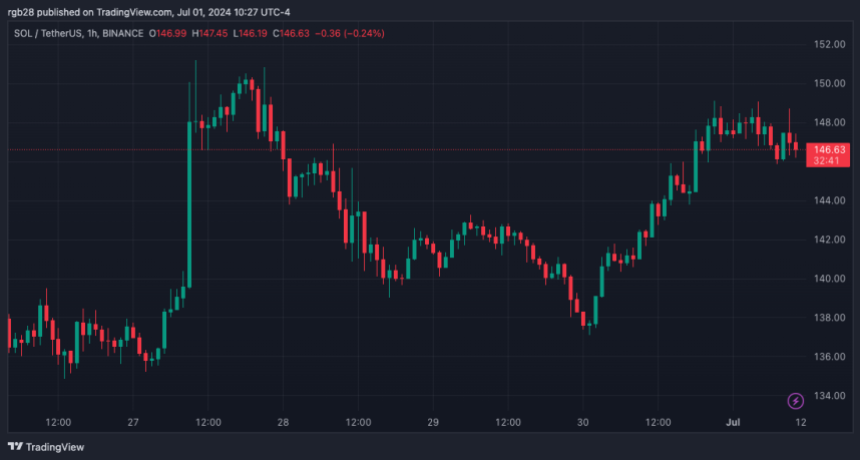Latest News
Why Swiss and Hong Kong crypto regulations will lead the DeFi revolution | MATIC News

The following is a guest post from James Davies, CEO of Crypto Valley Exchange.
Regulators worldwide, international organizations, and market participants have published many consultation papers, recommendations, and opinions. The writers include groups like the Global Financial Markets Association, the Institute of International Finance, the International Swaps and Derivatives Association, the Futures Industry Association, the Financial Services Forum, and IOSCO (International Organization of Securities Commissions).
All major players from Coinbase to Circle are publishing responses to the regulatory framework and legislative drafting worldwide.
All of this is brought together in an IOSCO paper, “Policy Recommendations for Crypto and Digital Asset Markets,” which, rather unbelievably, doesn’t mention permissionless protocols once and only decentralized in passing.
I pity the regulator that bases its crypto policy development on this publication. Separately, IOSCO published a “Policy Recommendation for Decentralized Finance,” which combines their analysis with the Financial Stability Board (FSB) report “The Financial Stability Risks of Decentralised Finance.”
However, and this is a major criticism, the papers miss the core idea of decentralized projects. Trying to succinctly explain where they are wrong and what they can do to shift the perspective takes more input from insiders. The essential goal of decentralized projects is “to create the project features as the result of emergent behaviors through the actions of unrelated and replaceable actors.”
These effects are emergent, making decentralized projects so difficult to regulate. The report makes some reasonable insights, such as run-risk on assets from liquidity mismatch, such as the events that collapsed TerraUSD/Luna, and the roll-forward of this hitting Celsius very reminiscent of the events in 2008, the “collateral chain” risk.
Notably, traditional finance regulators still do not cover this well, where banning new activities dominates integration and understanding.
It also makes valuable points on cross-border regulatory arbitrage; however, this is where it demonstrates very precisely that it doesn’t understand DeFi. These structures make identifying appropriate legal ownership/control and relevant legal authorities difficult. It presupposes that there is a legal ownership and control point, the antithesis of decentralization.
This doesn’t mean that there aren’t some DeFi entities that do have these, and while running via smart contracts on-chain are not more like centralized entities, these, though, will get picked up in the core of the rest of the crypto regulation.
IOSCO doubles down on these misapprehensions about how decentralization works in some of their recommendations to regulators, especially the recommendation to identify responsible persons. Comments suggesting layer-1 blockchains might be considered clearing and settlement operations feel bizarre.
Other areas to look at include leverage, lending pool structures, tokenization, pseudonymous information, reporting, IP, and off-chain/on-chain touchpoints. Continued adoption and growth are undoubted and will have major impacts on world economies and traditional finance over time.
Most notably, every respondent to IOSCO, that is, every major regulator, when asked to provide an overview of current regulatory treatment, stated that they do not have separate regulatory frameworks specially dedicated to DeFi activities. They further note that whilst respondents state that they have regulation for crypto underway, they are not specifically targeting DeFi. Respondents also express their views that existing frameworks can apply to DeFi protocols.
Like social scientists everywhere, the Bank of International Settlement also seeks to understand the DeFi landscape. Their process is being examined through the lens of categorizing DeFi. While they appear to do an adequate job in this respect, it comes across in the conventional manner of treating each project as a standalone company.
To summarize the areas of concern from IOSCO:
- Conflicts of interest arising from vertical integration of activities and functions
- Market manipulation, insider trading, and fraud
- Cross-borderrRisks and regulatory cooperation
- Custody and client asset protection
- Operational and technological risk
- Retail access, suitability, and distribution.
How should regulators look at DeFi?
Rigid classification-based regulation has led to many unintended consequences; Sarbanes-Oxley requirements drove companies away from public markets. The subprime mortgage crisis resulted from a focus on individual loans and not their aggregation. The initial responses to the rise of the Internet and digital business were slow and reactive. By the time regulations arrived, companies already had established practices. Uber and Airbnb’s growth was restricted by a patchwork of local regulations that didn’t support these business models.
Urban planners misunderstood the effect of adding roads, leading to more traffic issues rather than less. The climate models debate focuses on specifics rather than the emergent effects, clouding the issues.
Regulators should start with governance structures, not individual properties. DAOs typically have a presence of some form, such as an organization with a corporate identity, often because a Labs entity needs something to hold the equity to pay real-world bills.
These entities, though, are often controlled entirely through the DAO. Requiring DAO registration and setting up specific corporate entity types that match how they operate would add value. Setting transparency, reporting, voting, staking, delegation, and control rules would remove the ambiguity on how to operate. Weed out abusive entities that want to rug pull and encourage entities that want to operate in a decentralized manner genuinely.
There can be many further developments related to operation style, such as requiring those that border otherwise regulated activities to have the appointed people selected by the DAO to face future regulatory developments in these areas. However, engaging and setting a framework for DAO establishment would be a good start.
A second area for examination would be about mutual recognition, currently regulation is fragmented, in some areas such as derivatives markets mutual recognition works well, in payments and crypto it acts as a barrier to growth creating a difficult patchwork of regulation. If DAO regulation were recognized between major regulators, then regulating in one country would enable access to other countries, a major incentive to projects to choose a grown-up location for their DAO, a good indicator to users of the intent of those involved in the project.
More thought needs to be given to dealing with emergent properties related to aspects such as clearing and settlement. There are compelling reasons why these should exist. For a start, trading on-chain assets supported by on-chain collateral causes real issues for existing traditional finance aspects. We all want to support this tokenization and transparency push, but this doesn’t come without traditional finance equivalents. This is about the disintermediation of existing power bases and control and the empowerment of new economy models, but friction in these systems needs to drop to establish. It is almost the precise point of free markets.
Ethical behavior, transparency, and clarity at the top of the list, along with DAO registration and support, can begin this. Regulators will need to become much more educated in the mechanics of these protocols and their operations to ensure they slowly build the right regulation, not just restrictive regulation.
How Switzerland and Hong Kong have gotten right what the US gets wrong
The crypto industry is still largely in its infancy, and regulators are still figuring out how to oversee its various aspects, but not all efforts are equal.
Once a beacon of innovation, the US has become a challenging jurisdiction for crypto finance projects, let alone decentralized versions. It is well documented how the country’s relatively strong anti-crypto stance and enforcement-heavy approach has stifled growth, driving founders to seek more welcoming environments.
Meanwhile, Switzerland and Hong Kong have crafted regulatory frameworks that accommodate crypto and permissionless projects.
The Swiss Financial Market Supervisory Authority (FINMA) doesn’t regulate protocols based in Switzerland if the activities conducted on the protocol result from the actions of actors based outside Switzerland. They are accessible, transparent, and engaging. Self-regulatory approaches, in general, are well supported.
The Securities and Futures Commission (SFC) of Hong Kong assesses each Defi project on a case-by-case basis, balancing a “same business, same risk, same rules” approach for crypto in general with a more nuanced position on permissionless protocols. At the same time, the US Securities and Exchange Commission (SEC) has confused and caused the US to fall behind the pack.
The EU is focused on examining everything through a payments lens, and the UK talks a better game than it implements. By embracing crypto’s unique needs and fostering a culture of entrepreneurship, these jurisdictions have become the go-to destinations for crypto companies seeking regulatory clarity and freedom to experiment. They are likely to do the same with DeFi.
As DeFi continues to evolve and transform the financial landscape, the role of regulatory frameworks becomes crucial in shaping its trajectory. With digital assets gaining momentum, tokenization under discussion, and traditional finance entering the space, the quest for regulatory environments that not only accommodate but also nurture DeFi is intensifying more even than just centralized crypto entities.
Navigating the DeFi Regulatory Landscape
With the current hot crypto market and lots of capital flowing into projects, the number of projects establishing DAOs over the next 18 months will be huge.
From a regulatory perspective, it’s time for them to set out their intent for these entities and the services that will be possible through these protocols.
Regarding the regulatory landscape for current DeFi projects, we see why more and more industry professionals feel drawn toward Switzerland’s approach. While the EU’s MiCA Regulation offers a comprehensive, harmonized framework with detailed rules for consumer protection and market integrity – appealing for projects seeking a uniform environment for cross-border European operations – Switzerland’s principle-based approach, flexibility is more compelling for projects not focussed on payment services. Not every project fits neatly into a one-size-fits-all mold; Switzerland seems to understand that.
Switzerland’s willingness to foster a supportive ecosystem, exemplified by Crypto Valley in Zug, is remarkable. Being part of a vibrant community with access to capital and opportunities for experimentation and growth is a crypto native’s dream.
Switzerland’s regulatory philosophy and pro-business stance make it particularly appealing. Innovative projects will have a better opportunity, be more likely to get regulatory clarity early and emerge from this thriving ecosystem, pushing DeFi boundaries and shaping finance’s future evolution. Switzerland’s approach resonates persuasively.
Hong Kong: A Financial Renaissance
Hong Kong is redefining its role as a crypto hub by implementing its new Virtual Asset Service Provider (VASP) regime. This regulatory framework introduces a structured yet dynamic environment that supports crypto innovation while maintaining robust safeguards.
The comprehensive VASP licensing ensures crypto platforms meet stringent criteria for liquidity, customer protection, and cybersecurity, fostering a balanced approach to regulation and innovation. By permitting retail trading of cryptocurrencies, Hong Kong nurtures a vibrant ecosystem that attracts retail investors while upholding necessary safeguards. It has yet to develop Defi specific regulation, we can only encourage to look at this holistically, developing DAO regulation first, but the approach to the rest lends confidence that this is a good location for businesses to establish whilst we wait.
Regulatory routes forward
Countries mustn’t follow in the footsteps of those who have failed to innovate in this field. The US, for instance, has been slow to adapt to the changing financial landscape, with regulatory uncertainty stifling growth and innovation. Meanwhile, US companies keep demanding clarity on regulation, with giants like Coinbase and their legal team demanding the SEC engage in rulemaking. Similarly, countries like Japan and South Korea have struggled to integrate crypto into their traditional financial systems, leading to a lack of progress.
Countries, including the US, must divide and approach centralized and decentralized activities differently. Some decentralized activities, such as market rate set risk, have many risks that could be prevented fairly easily under the right approvals regime. We know this will come and squeeze some major players, but early transparency on the direction will save the industry a lot of costs.
Currently, we look to countries like Switzerland and Hong Kong, which have taken a proactive approach to crypto, to lead in creating a supportive regulatory environment that will foster innovation and growth in Defi. By learning from their example, other countries can catch up and move forward rapidly.
While the future of decentralized tech watches the American Dream turn into a coma, Swiss developers are pouring Aperol and planning their ski trips.
Latest News
Bahamas to provide CBDC access via commercial banks | MATIC News

The Bahamas will provide access to its central bank digital currency (CDBC) the “Sand Dollar” through commercial banks to increase adoption, Reuters reported on July 1, citing the country’s central bank governor.
Governor of the Central Bank of The Bahamas John Rolle said the country intends to establish the regulations within two years and has started signaling its intent to banks.
Rolle said:
“We foresee a process where all of the commercial banks will eventually be in that space and they will be required to provide their clients with access to the [CBDC].”
The Central Bank of the Bahamas reportedly sees the change as critical to raising CBDC and mobile payment adoption rates, even though banks will need to significantly modify their existing IT systems to comply with the upcoming obligations.
Rolle said uptake of the Sand Dollar is still limited years after its launch in 2020, requiring a shift from incentives to enforcement.
Adoption in question
Reuters described low adoption statistics amid the news. It reported that the CBDC accounts for under 1% of the country’s currency in circulation.
Reuters said wallet top-ups fell to $12 million in the eight months before August 2023 from $49.8 million in the same period in 2022, based on central bank data.
Rolle previously described “wide use, but very low average transaction value” in an interview with The New Times on June 19. He said 120,000 mobile wallets exist, equal to 20% of retail bank accounts, but mobile wallets make up less than 1% of retail payments.
Strong short-term data
A central bank press release from February described stronger short-term data. It recognized “modest seasonal growth in digital payments activities,” including the Sand Dollar, even though lower government transfer payments impacted overall year-to-date trends.
The bank said that the person-to-business (P2B) and business-to-business (B2B) transactions reached a combined $4.5 million, mainly involving the Sand Dollars, doubling from November 2022. It said personal wallet counts rose 20% year-to-date in December 2023. Sand Dollars in circulation rose 60.8% to $1.7 million.
Bahamas’ mandatory adoption policies could precede other strategies elsewhere. Reuters noted that the European Central Bank similarly intends to require retail and banks to accept and offer any future digital euro if it proceeds with one.
Latest News
Polkadot treasury holds $245M but faces revenue decline and two-year runway | MATIC News

The Polkadot Treasury holds assets equivalent to 38 million DOT, worth approximately $245 million. Head Ambassador Tommi Enenkel, popularly known as Alice and Bob, shared a new report providing the latest update on the network’s treasury.
This balance equates to about two years of the runway at its current spending rate. The report stated:
“At the current rate of spending, the Treasury has about two years of runway left, although the volatile nature of crypto-denominated treasuries makes it hard to predict with confidence.”
Polkadot’s first six months of spending
During the first six months of this year, Polkadot invested heavily in its ecosystem, spending 11 million DOT, valued at around $87 million, across various projects.
According to the report, the network invested about $37 million in Outreach activities such as advertisements, sponsorships, and events. The network signed sponsorship deals with race car driver Conor Daly and also pushed several marketing activities designed to bolster the network’s adoption by the broader global community.
Polkadot also spent $23 million developing its network features and upgrades, including SDK, Data Services and Indexing, Governance, and Subwallets.
Moreover, the network invested $15 million in liquidity incentives and $5.5 million in Talent and Education. Additionally, it spent $3.8 million to maintain the network and core ecosystem components, and another $2.1 million went towards Research.
Revenue decline
The report highlighted a decline in Polkadot’s revenue. During the first six months of the year, the network’s total earnings dropped to 171,696 DOT from 414,291 DOT, recorded in the second half of 2023.
Enenkel attributed this decline to the significant drop in network fees, which fell from 313,443 DOT last year to 39,444 DOT in the 2024 first half:
“We see that direct revenue from fees is still marginal. Polkadot made 300k DOT from fees in 2023-H2 from a short-lived inscriptions campaign. Fees under regular conditions are pretty stable with about 20k DOT per quarter. Other sources of revenue are typically transfers from accounts that return funds that they received and pay them back for various reasons.”
Disclaimer: CryptoSlate has received a grant from the Polkadot Foundation to produce content about the Polkadot ecosystem. While the Foundation supports our coverage, we maintain full editorial independence and control over the content we publish.
Latest News
Vitalik Buterin suggests ways to speed up Ethereum transaction confirmations | MATIC News

Ethereum co-founder Vitalik Buterin has suggested ways to help the blockchain improve its transaction confirmation times.
Buterin, in a June 30 blog post, explained that Ethereum’s Gasper consensus mechanism uses a slot-and-epoch architecture that contains certain complexities, like bug interactions and a 12.8-minute confirmation time, that makes it “more and more uncomfortable” for user experiences.
So, he highlighted some of the “practical options” Ethereum has to improve its user experience further.
SSF
Buterin stated that the single-slot finality (SSF) mechanism is similar to the Tendermint consensus, as it allows the finalization of blocks as soon as they are produced.
However, unlike the Tendermint consensus, Ethereum will keep the “inactivity leak” mechanism to allow chains to remain functional even if a third of the validators go offline. Buterin added that the single-slot finality mechanism also has its faults. Notably, all Ethereum stakers must publish two messages every 12 seconds, overloading the chain.
Meanwhile, Buterin furthered that while there are ideas to mitigate this issue, users may still have to wait 5-20 seconds. He wrote:
“There are clever ideas for how to mitigate this, including the very recent Orbit SSF proposal. But even still, while this improves UX significantly by making ‘finality’ come faster, it doesn’t change the fact that users need to wait 5-20 seconds.”
Rollup preconfirmations
Rollup preconfirmations aim to improve Ethereum’s Layer 2 (L2) solutions. These solutions process transactions with the same security as the Ethereum base layer (L1) but on a larger scale.
Rollups confirm transactions much faster than the current 5-20 seconds, targeting latencies of hundreds of milliseconds. This method divides responsibilities — the L1 network remains stable, censorship-resistant, and reliable, while the L2s offer faster transaction times and address user needs directly.
To achieve faster confirmations, L2s create decentralized sequencing networks. These networks have smaller groups of validators who quickly sign off on blocks, often within milliseconds, and commit them to the blockchain.
However, validators must ensure their commitments are consistent and trustworthy. If a validator signs conflicting blocks, they risk losing their deposits.
Based preconfirmations
Based preconfirmations leverage Ethereum proposers’ advanced capabilities, driven by Maximum Extractable Value (MEV) prospects.
The concept involves establishing a standardized protocol where users can pay an extra fee for immediate assurance that their transaction will be included in the upcoming block. This service, known as preconfirmations-as-a-service, would assure users of swift transaction confirmation.
Proposers who fail to fulfill their commitment or breach the agreement face penalties (slashing). Buterin noted that this framework will apply to L1 transactions and extend to L2 solutions. By treating all L2 blocks as L1 transactions, the preconfirmation mechanism ensures accelerated confirmations throughout the Ethereum network.
Buterin noted that Ethereum implementing SSF and rollup or based preconfirmations could significantly reduce transaction confirmation times.
However, he pointed out that this would return to the initial “epoch-and-slot architecture” the blockchain was trying to ditch. He stated:
“There is a deep philosophical reason why epoch-and-slot architectures seem to be so hard to avoid: it inherently takes less time to come to approximate agreement on something, than to come to maximally-hardened ‘economic finality’ agreement on it.”
He suggested that the network developers explore other options that are not as tightly interwoven as Gasper.
Mentioned in this article
-

 Hot Projects4 months ago
Hot Projects4 months agoBitcoin Blasts Past $70,000 to Register New All-Time High | MATIC News
-

 Latest News4 months ago
Latest News4 months agoCourt upholds SEC’s unregistered securities claims against Gemini, Genesis’ Earn program | MATIC News
-

 Latest News2 months ago
Latest News2 months agoSix Coinbase customers claim the exchange is violating securities laws in new lawsuit | MATIC News
-
Hot Projects2 months ago
Bitcoin Will Be Set For New ATHs If It Breaks This Resistance: Analyst | MATIC News
-

 Hot Projects3 months ago
Hot Projects3 months agoBitcoin ETF Inflows Could Eclipse $1 Trillion, Predicts Bitwise CIO | MATIC News
-

 Hot Projects3 months ago
Hot Projects3 months agoOndo Finance Joins BlackRock Tokenized Fund As Inflows Surpass $160M | MATIC News
-

 Latest News4 months ago
Latest News4 months agoOver $1 billion wiped off HEX’s valuation following Richard Heart’s disparaging remarks | MATIC News
-

 Latest News2 months ago
Latest News2 months agoNew Hampshire representative proposes Bitcoin ETF investment to address state financial liabilities | MATIC News




